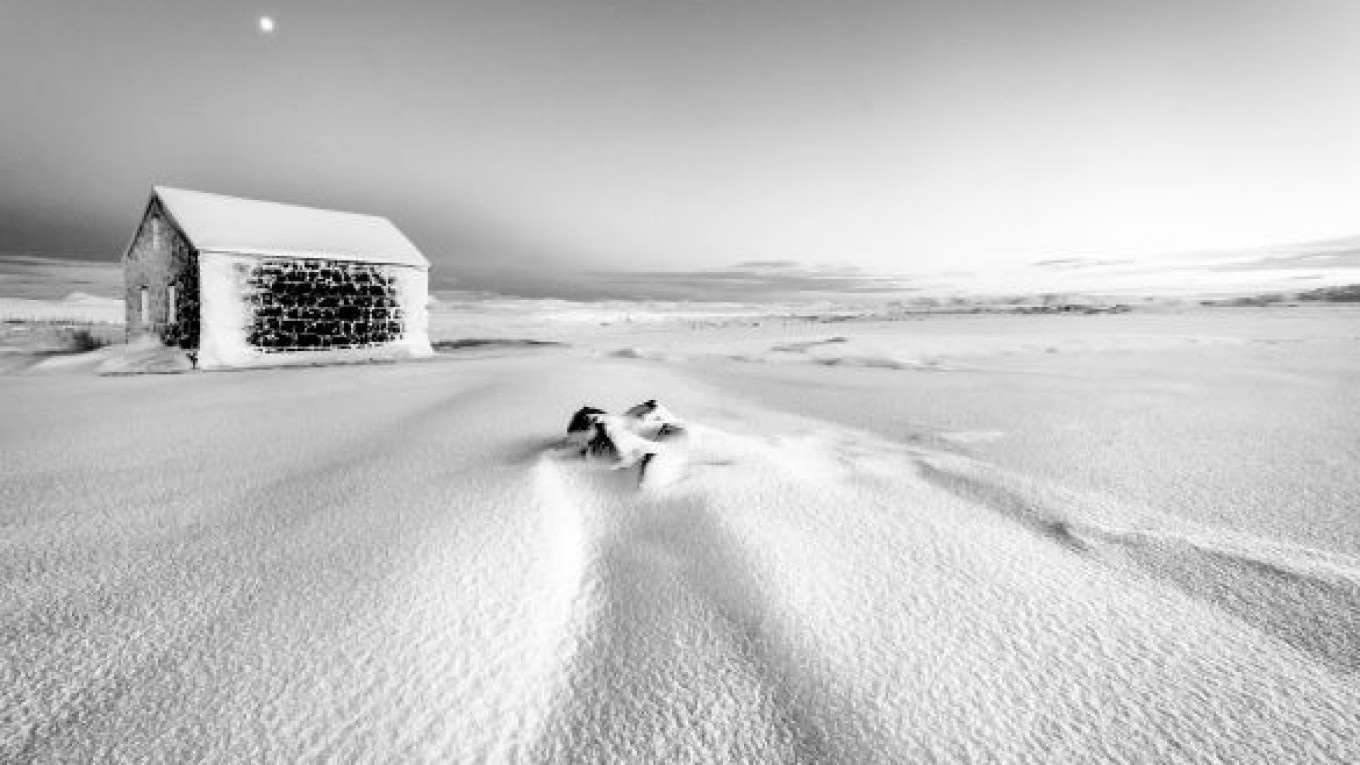Winter has not yet descended upon Moscow. The air is crisp and the temperatures are falling but, despite reports of flurries, there is no snow on the ground, and the cold has only begun to nip noses rather than grip onto people's souls.
A fitting preparation for the season may be Gunnar Gunnarsson's "Advent," a novella which has now been translated into Russian for the first time with the subtitle "The Story of a Good Shepherd." An event launching the book last Friday at the Winzavod Center for Contemporary Art's FotoLoft gallery was accompanied by a photo exhibit from Sigurjon Petursson entitled "Advent in the Highlands." The project began several years ago after Gunnar Gunnarsson's greatgrandson, Gunnar Björn Gunnarsson, saw one of the photographer's photos and was reminded of the cabin that plays a role in the book.
Petersson and the Institute of Gunnar Gunnarsson, which holds the copyright to four of the author's books including "Advent" and is headed by Skuli Björn Gunnarsson, then teamed up for a project where the photographer selected 70 passages from the novella, which follows the journey of a shepherd Benedikt. As the title suggests, the story is set around Christmas time and sees Benedikt go out into the snow of eastern Iceland to search for a lost sheep with the companionship of another sheep and his dog Leo. Playing on obvious Christian connections, the book takes on a spiritual dimension when the shepherd begins asking himself life's existential questions.
Though Muscovites need no reminder of what snow looks like, Petursson's photographs, true to the book's storyline, show a lot of it. Shot during a series of expeditions into the Icelandic wilderness, the photos act as illustrations of events in the novella, such as a picture of a candlestick with the quotation: "It is a service of love for a light not to leave it devouring itself to no purpose, but rather to awaken it again, when the occasion arises, to new life and new service." Other photos show the snow-covered cliffs and icy rivers of eastern Iceland, where a middle-aged Gunnarsson lived at Skriduklaustur, now home to the institute that bears his name. These black and white photos — mostly white — are connected to the book's more philosophical passages where Benedikt searches for meaning in the natural world.
Given the focus on Russian literature's familiar themes of fluffy white winter precipitation, spirituality and nature, it may seem odd that the book is only now being translated for Russian readers. The book, originally printed in Danish in 1937 and now taught in Icelandic schools, had been translated into German and English by 1940. Gunnarsson, who was born in 1899 and first published while living in Denmark during the 1910s, achieved widespread popularity in Nordic countries. He gave a series of lectures in fascist Germany that included a meeting with Adolf Hitler, an event that some observers speculate may have cost him the Nobel Prize in literature. Rumored to have been nominated several times in the 1920s, Gunnarsson was reportedly slated to share the 1955 prize with fellow Icelander Halldor Laxness before the Nobel committee decided to award Laxness alone.
The author's great-grandson said that despite the controversy, Gunnarsson and his work are nonpolitical. However the writer's descendant acknowledged that the novelist openly advocated for a union of all the early 20th century Scandinavian states into one country and said, "In the same way Russia had a revolution, my great-grandfather wanted to dismiss all the kingdoms of Sweden, Norway and Denmark."
The younger Gunnarsson said his forebearer's ideas about unity may have been inspired by his brief time in Russia, when he reported from Red Square for a Danish magazine during the 10th anniversary celebration of the Bolshevik revolution.
While the Soviet ceremony struck a chord with the writer, Russians may receive a similarly strong impression from Gunnarsson's work and the projects inspired by it. The Institute of Gunnar Gunnarsson first approached the book's Russian publisher, TEXT, with the translation project after Russia's ambassador to Iceland became captivated by the photos at Petursson's house.
“Advent in the Highlands” runs until Oct. 20 at the FotoLoft Gallery in the Winzavod Contemporary Art Center, 14th Syromyatnichesky Pereulok, Bldg. 6.
Contact the author at [email protected]
A Message from The Moscow Times:
Dear readers,
We are facing unprecedented challenges. Russia's Prosecutor General's Office has designated The Moscow Times as an "undesirable" organization, criminalizing our work and putting our staff at risk of prosecution. This follows our earlier unjust labeling as a "foreign agent."
These actions are direct attempts to silence independent journalism in Russia. The authorities claim our work "discredits the decisions of the Russian leadership." We see things differently: we strive to provide accurate, unbiased reporting on Russia.
We, the journalists of The Moscow Times, refuse to be silenced. But to continue our work, we need your help.
Your support, no matter how small, makes a world of difference. If you can, please support us monthly starting from just $2. It's quick to set up, and every contribution makes a significant impact.
By supporting The Moscow Times, you're defending open, independent journalism in the face of repression. Thank you for standing with us.
Remind me later.






